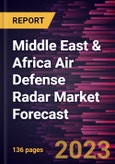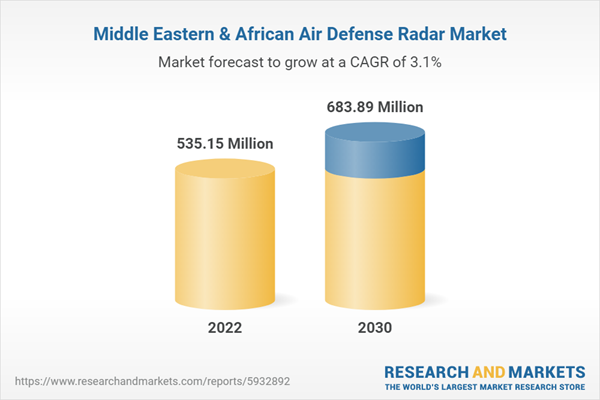Development of Miniaturized and Low-Cost Radars Fuel the Middle East & Africa Air Defense Radar Market
The development of miniaturized and low-cost radars is due to technological advancements, such as improved semiconductor manufacturing processes and the miniaturization of associated components. These advancements enable the development of smaller, lighter, and more cost-effective radar systems or miniaturized radar systems compared to traditional ones without compromising performance. Their compact form makes them more accessible and adaptable to different operational requirements and environments. This feature also allows easier integration of radars into various platforms, such as ground-based systems, naval vessels, or unmanned aerial vehicles (UAVs). The flexibility and adaptability of miniaturized radars make them suitable for diverse operational environments, expanding their market potential. Further, the various market players are focusing more on the cost efficiency of the air defense radar systems. For instance, radar systems such as multifunction radar systems offer enhanced operational efficiency by integrating multiple radar capabilities into a single platform. The ability to perform multiple tasks with a single system increases operational efficiency and cost-effectiveness. Thus, the market is witnessing the growing trend of miniaturized and low-cost radars development.Middle East & Africa Air Defense Radar Market Overview
Several countries in the Middle East & Africa have been suffering the consequences of increasing missile threats, technological innovations in ballistic missile systems, and a rise in terrorist activities, which has resulted in an upsurge in their defense budgets, and demand for air surveillance and traffic management solutions in these countries. An increased need for border protection owing to the rising geopolitical tension compels governments and defense authorities to extensively invest in modern radar systems to boost their air defense capabilities. In 2022, major countries in MEA (considered in the scope) invested US$ 146.7 billion in total in military technologies. According to several military sources, the region accounted for more than 321 naval vessels in 2023; countries such as South Africa, Saudi Arabia, and the UAE collaboratively commissioned ~54 naval vessels for future procurement across the region. Thus, the increased threat of terrorism and regional conflicts is one of the primary factors driving the growth of the air defense radars market in the Middle East & Africa. Air defense radars are essential for detecting and tracking airborne threats such as enemy aircraft, drones, and missiles, allowing for prompt response and effective defense measures. These abilities lead to the demand for air defense radar systems that are deployed on naval vessels.The Middle East & Africa is home to several countries with significant oil reserves, making them prime targets for potential attacks. Protecting critical infrastructures, such as oil fields, refineries, and transportation networks, requires robust air defense capabilities. Consequently, governments in the region are investing in advanced radar systems to protect their valuable assets. Moreover, growing defense budgets in countries in the Middle East & Africa provide the necessary financial support for acquiring and modernizing air defense radars. Nations such as Saudi Arabia, the UAE, Egypt, and Israel have been at the forefront of procuring advanced radar systems to strengthen their military capabilities. Countries in this region are collaborating with international defense manufacturers and suppliers to develop and deploy state-of-the-art radar technologies.
Middle East & Africa Air Defense Radar Market Revenue and Forecast to 2030 (US$ Million)
Middle East & Africa Air Defense Radar Market Segmentation
The Middle East & Africa air defense radar market is segmented into function, range, system type, platform, application, and country.Based on function, the Middle East & Africa air defense radar market is segmented into synthetic aperture radar and moving target indicator radar, surveillance radar, airborne early warning radar, multi-functional radar, weather radar, and others. The synthetic aperture radar and moving target indicator radar segment held a largest share of the Middle East & Africa air defense radar market in 2022.
Based on range, the Middle East & Africa air defense radar market is segmented into short range, medium range, and long range. The long range segment held the largest share of the Middle East & Africa air defense radar market in 2022.
Based on system type, the Middle East & Africa air defense radar market is segmented into fixed radar, and portable radar. The fixed radar segment held the largest share of the Middle East & Africa air defense radar market in 2022.
Based on platform, the Middle East & Africa air defense radar market is segmented into ground-base, aircraft-mounted, and naval based. The ground-base segment held the largest share of the Middle East & Africa air defense radar market in 2022.
Based on application, the Middle East & Africa air defense radar market is segmented into ballistic missile defense, identification friend or foe, weather forecasting, and others. The identification friend or foe segment held the largest share of the Middle East & Africa air defense radar market in 2022.
Based on country, the Middle East & Africa air defense radar market is segmented int o South Africa, Saudi Arabia, the UAE and the Rest of Middle East & Africa. The Rest of Middle East & Africa dominated the Middle East & Africa air defense radar market in 2022.
BAE Systems Plc, General Dynamics Corp, Honeywell International Inc, Israel Aerospace Industries Ltd, Leonardo SpA, Lockheed Martin Corp, Northrop Grumman Corp, Raytheon Technologies Corp, Saab AB, and Thales SA are some of the leading companies operating in the Middle East & Africa air defense radar market.
Table of Contents
Executive Summary
At 3.1% CAGR, the Middle East & Africa Air Defense Radar Market is speculated to be worth US$ 683.89 million by 2030.According to this research, the Middle East & Africa air defense radar market was valued at US$ 535.15 million in 2022 and is expected to reach US$ 683.89 million by 2030, registering a CAGR of 3.1% from 2022 to 2030. Rise in number of contracts for supply of air defense radar , continuous rise in defense spending, and rise in cross-border conflicts are among the critical factors attributed to the Middle East & Africa air defense radar market.
Cross-border conflicts often involve threats from airborne platforms, including aircraft, UAS, and missiles. Air defense radar systems play a vital role in border surveillance by detecting and tracking these threats, providing early warning and enabling rapid response capabilities, including evacuation measures. Cross-border conflicts might also lead to the destruction of critical infrastructure, such as airports, power plants, and various government-based facilities. The need for enhanced surveillance to safeguard borders and other critical infrastructure drives the demand for advanced radar systems, including air defense radar systems, in conflict zones. In addition, military forces often establish forward operating bases (FOBs) near conflict zones. These FOBs require robust air defense capabilities to protect personnel and equipment. Air defense radar systems are integral to FOBs, providing surveillance, detection, and response capabilities against airborne threats. Thus, the increase in the utilization of air defense radars in conflict areas is expected to create opportunities for the Middle East & Africa Air Defense Radar Market growth in the coming years.
On the contrary, threat of jamming and spoofing hampers the Middle East & Africa air defense radar market.
Based on function, the Middle East & Africa air defense radar market is segmented into synthetic aperture radar and moving target indicator radar, surveillance radar, airborne early warning radar, multi-functional radar, weather radar, and others. The synthetic aperture radar segment held 30.5% share of Middle East & Africa air defense radar market in 2022, amassing US$ 163.36 million. It is projected to garner US$ 198.48 million by 2030 to expand at 2.5% CAGR during 2022-2030.
Based on range, the Middle East & Africa air defense radar market is segmented into short range, medium range, and long range. The long range segment held 44.3% share of Middle East & Africa air defense radar market in 2022, amassing US$ 236.80 million. It is projected to garner US$ 284.31 million by 2030 to expand at 2.3% CAGR during 2022-2030.
Based on system type, the Middle East & Africa air defense radar market is segmented into fixed radar, portable radar. The fixed radar segment held 65.1% share of Middle East & Africa air defense radar market in 2022, amassing US$ 348.54 million. It is projected to garner US$ 433.05 million by 2030 to expand at 2.8% CAGR during 2022-2030.
Based on platform, the Middle East & Africa air defense radar market is segmented into ground-base, aircraft-mounted, and naval based. The ground-based segment held 46.2% share of Middle East & Africa air defense radar market in 2022, amassing US$ 247.13 million. It is projected to garner US$ 313.70 million by 2030 to expand at 3.0% CAGR during 2022-2030.
Based on application, the Middle East & Africa air defense radar market is segmented into ballistic missile defense, identification friend or foe, weather forecasting, and others. The identification friend or foe segment held 51.4% share of Middle East & Africa air defense radar market in 2022, amassing US$ 275.22 million. It is projected to garner US$ 367.30 million by 2030 to expand at 3.7% CAGR during 2022-2030.
Based on country, the Middle East & Africa air defense radar market has been categorized into the South Africa, Saudi Arabia, the UAE, and the Rest of Middle East and Africa. Our regional analysis states that the Rest of Middle East & Africa captured 47.8% share of Middle East & Africa air defense radar market in 2022. It was assessed at US$ 255.57 million in 2022 and is likely to hit US$ 350.75 million by 2030, exhibiting a CAGR of 4.0% during 2022-2030.
Key players operating the Middle East & Africa air defense radar market are BAE Systems Plc, General Dynamics Corp, Honeywell International Inc, Israel Aerospace Industries Ltd, Leonardo SpA, Lockheed Martin Corp, Northrop Grumman Corp, Raytheon Technologies Corp, Saab AB, and Thales SA, among others.
Companies Mentioned
- BAE System Plc
- General Dynamics Corp
- Honeywell International Inc
- Israel Aerospace Industries Ltd
- Leonardo SpA
- Lockheed Martin Corp
- Northrop Grumman Corp
- Raytheon Technologies Corp
- Saab AB
- Thales SA
Table Information
| Report Attribute | Details |
|---|---|
| No. of Pages | 136 |
| Published | December 2023 |
| Forecast Period | 2022 - 2030 |
| Estimated Market Value in 2022 | 535.15 Million |
| Forecasted Market Value by 2030 | 683.89 Million |
| Compound Annual Growth Rate | 3.1% |
| Regions Covered | Africa, Middle East |
| No. of Companies Mentioned | 10 |









